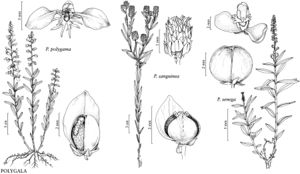Polygala sanguinea
Sp. Pl. 2: 705. 1753.
Herbs annual, single-stemmed, (0.5–) 1–4 dm, usually branched distally; from taproot (or rarely fibrous-root cluster). Stems erect, glabrous. Leaves alternate; sessile or subsessile; blade spatulate proximally to linear or narrowly elliptic distally, (5–) 10–20 (–40) × (0.5–) 1–3 (–5) mm, base acute or obtuse, apex acute to acuminate, surfaces glabrous. Racemes capitate to densely cylindric, (0.5–) 1–2 (–4) × 0.5–1.4 cm; peduncle 0.3–2.5 (–3) cm; bracts subpersistent to tardily deciduous, subulate. Pedicels 0.4–1.5 mm, glabrous. Flowers usually pink, purple, or reddish purple, rarely white, sometimes greenish tinged, sepals sometimes pink or white, 4–6 mm; sepals oval, elliptic-ovate, or lanceolate, 1–3 mm; wings ovate to broadly elliptic, (2.6–) 4.5–6.3 × (1–) 2.5–3.5 mm, apex obtuse to broadly rounded, sometimes minutely apiculate, rarely acute; keel 2.5–3 mm, crest 2-parted, with 2–4 lobes on each side. Capsules usually with flattened, sterile base, cuneate-subglobose, 2.5–3 × 2–2.5 mm, margins not winged (sometimes with raised rim). Seeds 1.3–1.7 mm, pubescent; aril 1–1.3 mm, lobes usually (1/2–) 2/3 to ± length of seed, rarely minute.
Phenology: Flowering spring–summer.
Habitat: Prairies, old fields, gravelly logging road margins, meadows, glades, bogs, flatwoods, open woods.
Elevation: 0–300 m.
Distribution
N.B., N.S., Ont., P.E.I., Que., Ala., Ark., Conn., Del., D.C., Ga., Ill., Ind., Iowa, Kans., Ky., La., Maine, Md., Mass., Mich., Minn., Miss., Mo., Nebr., N.H., N.J., N.Mex., N.Y., N.C., Ohio, Okla., Pa., R.I., S.C., S.Dak., Tenn., Tex., Vt., Va., W.Va., Wis.
Discussion
Polygala sanguinea is the only species of the genus in the flora area with the wings to twice the length of the keel. Late season flowers can have much smaller wings, some as small as 2.6 × 1 mm.
Selected References
None.
